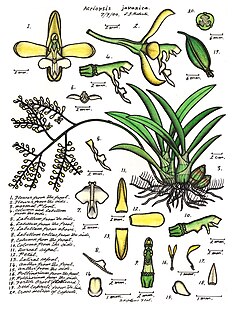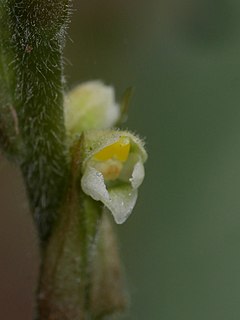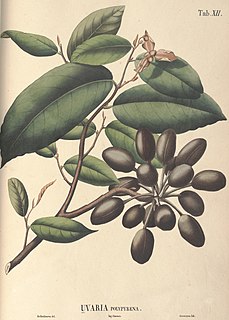
Charles Ludwig de Blume or Karl Ludwig von Blume was a German-Dutch botanist. The standard author abbreviation Blume is used to indicate this person as the author when citing a botanical name.

Tainia, commonly known as ribbon orchids or 带唇兰属 is a genus of about thirty species of evergreen, terrestrial orchids in the distributed from India, China, Japan, Southeast Asia to New Guinea, the Solomon Islands and Queensland.

Acriopsis, commonly known as chandelier orchids or 合萼兰属 is a genus of flowering plants in the family Orchidaceaes. Orchids in this genus are epiphytic herbs with spherical or cylindrical pseudobulbs, creeping, branched rhizomes, thin white roots, two or three leaves and many small flowers. The flowers are non-resupinate with the lateral sepals joined along their edges and have spreading petals and a three-lobed labellum. The column has projections that extend hood-like beyond the anther.

Acriopsis javanica is a species of orchid that is native to Southeast Asia, New Guinea, some Pacific islands and northern Australia. It is a clump-forming epiphyte with dark green leaves and curved, branching flower stems with many white and cream-coloured flowers with purple markings.

Spathoglottis plicata, commonly known as the Philippine ground orchid, or large purple orchid is an evergreen, terrestrial plant with crowded pseudobulbs, three or four large, pleated leaves and up to forty resupinate, pink to purple flowers. It is found from tropical and subtropical Asia to Australia and the western Pacific including Tonga and Samoa.

Bulbophyllum longiflorum, commonly known as the pale umbrella orchid, is a species of epiphytic or lithophytic orchid. It has a creeping rhizome, widely spaced, dark green pseudobulbs with a single large, fleshy leaf, and flowers spreading in a semicircular umbel, resembling one-half of an umbrella. The flowers are canoe-shaped, greenish cream-coloured to yellowish with purple dots. It has a wide distribution and is found in parts of Africa, on islands in the Indian and Pacific Oceans, Southeast Asia, New Guinea and northern Australia.
Cystorchis is a genus of flowering plants from the orchid family, Orchidaceae. It has 21 currently accepted species, native to New Guinea, Southeast Asia, and the islands of the western Pacific.
- Cystorchis aberransJ.J.Sm.
- Cystorchis aphyllaRidl.
- Cystorchis appendiculataJ.J.Sm.
- Cystorchis celebicaSchltr.
- Cystorchis dentiferaSchltr.
- Cystorchis gracilis(Hook.f.) Holttum
- Cystorchis javanica(Blume) Blume
- Cystorchis luzonensisAmes
- Cystorchis macrophysaSchltr.
- Cystorchis marginataBlume
- Cystorchis ogurae(Tuyama) Ormerod & P.J.Cribb
- Cystorchis orphnophillaSchltr.
- Cystorchis peliocaulosSchltr.
- Cystorchis ranaiensisJ.J.Sm.
- Cystorchis rostellataJ.J.Sm.
- Cystorchis saccosepalaJ.J.Sm.
- Cystorchis salmoneusJ.J.Wood
- Cystorchis saprophyticaJ.J.Sm.
- Cystorchis stenoglossaSchltr.
- Cystorchis variegataBlume
- Cystorchis versteegiiJ.J.Sm.

Vrydagzynea, commonly called tonsil orchids, is a genus of orchids in the tribe Cranichideae. About forty five species of Vrydagzynea have been formally described. They are native to India, Taiwan, Southeast Asia, Malesia, Melanesia and Polynesia. A single species in Australia is possibly extinct. They have thinly textured, stalked leaves and small, dull-coloured resupinate flowers with the dorsal sepal and petals overlapping to form a hood over the column.

Thelasis, commonly known as fly orchids, is a genus of flowering plants from the orchid family, Orchidaceae. Plants in this genus are usually epiphytes, sometimes lithophytes or rarely terrestrials. Some species have pseudobulbs with up to three leaves, whilst others have several leaves in two ranks. A large number of small, white or greenish yellow flowers are borne on a thin, arching flowering stem. There are about thirty species, distributed from tropical and subtropical Asia to the southwest Pacific.

Abraham Jacobus Wendel was a Dutch lithographer, draughtsman and scientific botanical and paleontological illustrator using the signature AW and A. J. Wendel

Hetaeria oblongifolia, commonly known as the hairy jewel orchid, is a species of orchid that is native to Southeast Asia, New Guinea and Queensland. It has between four and eight egg-shaped, dark green leaves and up to forty five small, hairy green and white flowers with a deep pouch near the base of the labellum.

Goodyera rubicunda, commonly known as the giant jewel orchid, is a species of orchid that is native to parts of India, Asia, Southeast Asia, New Guinea, Queensland and some Pacific Islands where it grows in damp forest and rainforest. It has between three and six large, egg-shaped leaves and up to ten dull pink and white resupinate flowers that are hairy on the outside.

Eulophia venosa, commonly known as the pointed corduroy orchid, is a plant in the orchid family and is native to India, parts of Southeast Asia as well as New Guinea and northern Australia. It is a deciduous, terrestrial orchid with one large and one small leaf and between six and twenty pale green or yellowish flowers with purple markings. It grows in rainforest and grassy forests.

Pachychila pubescens, commonly known as pink kunai orchid or as 粉口兰 , is a plant in the orchid family. It is native to areas from Asia through Southeast Asia to New Guinea and northern Australia. It is a deciduous, terrestrial herb with one or two grass-like leaves and up to ten dull pink, more or less drooping flowers. It grows in wet, grassy places in forests and woodlands.
Tainia trinervis, commonly known as the ribbon orchid, is an evergreen, terrestrial plant with crowded pseudobulbs, each with a single smooth, shiny leaf and up to fourteen greenish to yellowish flowers with red or purplish stripes in the middle. It is found in tropical Southeast Asia, New Guinea and northern Australia.
Dendrobium convexum, commonly known as the piggyback orchid, is an epiphytic orchid in the family Orchidaceae. It has a creeping, brittle root, erect pseudobulbs with a single leaf on the top and one or two cream-coloured, short-lived flowers with a red and yellow labellum. It is native to Southeast Asia, New Guinea and tropical North Queensland, Australia.

Luisia tristis, commonly known as the velvet orchid, is a species of epiphytic or lithophytic orchid with wiry stems often forming tangled clumps, cylindrical leaves and flowering stems with up to three green flowers with a dark red to dark maroon labellum. This orchid occurs in tropical Asia, New Guinea, Australia and some islands of the Western Pacific Ocean.
Thelasis capitata, commonly known as the conical fly orchid, is a plant in the orchid family. It is a clump-forming epiphyte with flattened pseudobulbs, each with a single strap-shaped leaf. A large number of small yellowish green flowers are arranged in a cone shape on a thin but stiff flowering stem. This orchid is found from Thailand to Malesia, including on Christmas Island.

Thelasis carinata, commonly known as the triangular fly orchid, is a plant in the orchid family. It is a clump-forming epiphyte or lithophyte that lacks pseudobulbs. There are groups of between two and six erect, flattened stems each with up to six leaves that have a ridged lower surface. Up to fifteen green and white flowers are arranged on a thin but stiff flowering stem. This orchid is found from Thailand to the southwest Pacific.

Mitrephora polypyrena is a species of plant in the family Annonaceae. It is native to Java, the Lesser Sunda Islands, and Myanmar. Carl Ludwig Blume, the German botanist who first formally described the species using the basionym Uvaria polypyrena, named it after the many stones or seeds in its fruit.














